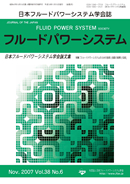All issues

Volume 38 (2007)
- Issue 6 Pages 77-
- Issue 5 Pages 65-
- Issue 4 Pages 49-
- Issue 3 Pages 35-
- Issue 2 Pages 13-
- Issue 1 Pages 1-
Volume 38, Issue 6
Displaying 1-2 of 2 articles from this issue
- |<
- <
- 1
- >
- >|
Paper
-
(Flow Control by Geometry Close to Nozzle Outlets and Impinged Surfaces)Toshiharu KAZAMA, Yorihito MIURA2007Volume 38Issue 6 Pages 77-82
Published: 2007
Released on J-STAGE: May 22, 2009
JOURNAL FREE ACCESSAn experiment related to cavitation erosion was conducted by utilizing submerged cavitating jet rigs. Using seven types of nozzle holders and six different height of cylindrical walls, the effects of geometry of the nozzle outlets and the impinged surfaces on erosion were examined. Tap water and ISO VG32 hydraulic oil were used as the test liquids. The time evolution of mass loss and cross-sectional profiles of the specimens were measured. At the same time, the cavity-clouds of the jets were recorded with a video camera and the pictures were processed with a personal computer. In conclusion, 1) The concave-type surface of the specimens gave a substantial reduction in erosion; 2) Mass loss of the specimens was decreased for a specific geometry of the nozzle outlets; 3) Erosion by use of tap water was markedly more severe than that of the mineral oil, and 4) Correlation between the erosion of the specimens and the processed pictures of the cavitating jets was partially shown.View full abstractDownload PDF (731K) -
Masaaki SHINADA2007Volume 38Issue 6 Pages 83-89
Published: 2007
Released on J-STAGE: May 22, 2009
JOURNAL FREE ACCESSWith large hydraulic systems, a transient unexpected high-pressure surge often occurs in the branch passage of an auxiliary valve in the valve box at the transition of the working cycle. This pressure surge reaches 5 to 6 times that produced in the main line, and may occasionally give rise to system failure. This paper presents experimental and SMA simulation analyses for the fluid transients produced at the beginning stage of the decompression cycle of a large hydraulic casting machine, and physically elucidates the generation mechanism of the unexpected high-pressure surge. Measures for prevention of these pressure surges are also presented, and their effectiveness is verified by experiment. A simplified method of estimation of the unexpected high-pressure surge is proposed for various kinds of hydraulic systems, and its usefulness is verified by experiments carried out on testing of small hydraulic pipeline systems. In addition, a new calculation method is proposed for applying the SMA method to cases where there is a hydraulic casting machine in which the system consists of several hydraulic complex pipelines connected by several non-linear hydraulic components and column separation occurs at the inner point of the complex pipeline. From comparison of the simulation results with the experimental results, it is shown that the simulation accuracy of this calculation method is very high.View full abstractDownload PDF (777K)
- |<
- <
- 1
- >
- >|